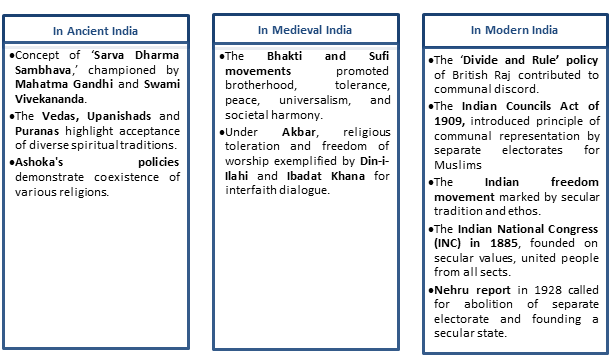It means state should protect all religions equally and does not itself uphold any one religion as state religion. Two broad meanings:
-
- Separation of religion from the statee. Dharm Nirpekshta.
- Equal respect to all religions by statee. Sarva Dharma Samabhava.
Evolution of secularism in India:

Secularism In West
It was the thinkers of the age of Enlightenment in Europe from the late 17th to the late 18th century whose work on church and state gave birth to a full theory of secularism
-
- In 1689, John Locke was one of the first to talk about state to be distinct from religion.
- In 1851, Jacob Holyoake was the first philosopher/scholar to use the term ‘secular’.
- Thomas Jefferson first to clearly state that there should be a wall between the church and state.
Difference between Indian and Western Secularism
| Western secularism | Indian secularism |
|---|---|
| • It embodies a negative concept of secularism. • In this state neither recognise nor intervenes in the religious affairs. • It emphasises the complete separation of religion from state. • The state cannot financially support religious educational institutions or hinder religious activities, provided they comply with the law. • It has no place for the idea of state-supported religious reform. • It considers religion more as a privatematter that should have no influence on state affairs. • Individual rights take precedence in Western secularism. • For example-In France, wearing religious symbol is not allowed in public spaces. | • It embodies a positive concept of secularism. • The state recognizes and respects all religions equally, without showing favouritism to any one religion. • It does not advocate complete separation of state and religion. • The Indian Constitution allows for partial financial support of religious schools and state funding for religious buildings and infrastructure. • Indian secularism is compatible with the idea of state-supported religious reform.Example: Constitution bans untouchability. • It is more proactive and interactive. • Indian secularism deals with religious freedom of individuals and minority community. • For example- India |
Secularism in Indian context:
-
- Indian Constitution guarantees secularism under Article 14, 15, 16, 25-28, 29, 30, 44, 45.
- Indian society is multi-religious and multi-cultural with high level of inequality and backwardness.
- No strict water-tight separation between state and religion. The state can enact reforms to address negative aspects of religion, such as the Sabarimala Judgment permitting women’s entry into temples.
- The positive tenets of religioncan be adapted into State practices. For example, removal of the old system of Communal Representation in Politics.
- Rajeev Bhargava’s “Principled Distance” model i.e. flexible state-religion relations. It emphasizes mutual respect, non-discrimination, and accommodative secularism, while fostering inclusive democratic dialogue and protecting individual rights.
Judicial pronouncements on secularism in India
-
- Kesavananda Bharati case, 1973 (secularism as basic structure)
- Indira Nehru Gandhi v. Raj Narain(1975)- SC defined secularism
- R. Bommai vs Union of India case, 1994 (explicit recognition of secularism)
- Noorjehan Safia Niaz v. State of Maharashtra (2016)
- In Shayara Bano v. Union of India (2017)
- Indian Young Lawyers Association vs. the State of Kerala (Sabarimala case)
Perspectives of Indian leaders for Secularism:
| Leaders | Perspectives on Secularism |
|---|---|
| M.K. Gandhi | - Sarva Dharma Samabhava- equal respect for all religions and the freedom to practice without persecution. - Opposed communalism, emphasizing unity and common humanity over divisive religious or ethnic lines. - Advocated for a secular society where individuals govern themselves based on conscience. - Believed in the separation of religion and politics - Criticized religious fundamentalism and atheism, emphasizing religion as an individual choice. |
| Jawaharlal Nehru | - Secularism as essential to modern democracy, advocating for equal treatment of all citizens regardless of religion. - Emphasized separation of state and religion - secularism as a tool for promoting national unity and social harmony |
| Dr. B.R. Ambedkar | - Advocated secularism to ensure social justice and equality, promoting unity among India's diverse population. - Emphasized state neutrality towards all religions and castes - Religious freedom as crucial for protecting individual rights - Secularism essential for eliminating caste system and addressingreligious discrimination |
Working of secularism in India:
| Positives | Negatives | Way forward |
|---|---|---|
| • Landmark judgementssuch as the Shah Bano case, which upheld the rights of Muslim women. • Religious freedom as various religious festivals and celebrations are observed nationwide. • Interfaith harmony joint celebrations of festivals like Diwali, Eid, and Christmas. • Protection of minority rights: Institutions likeNCMand various welfare schemes. | • Communal riotssuch as the Gujarat riots (2002),anti-Sikh riots (1984)and the recently in Nuh, Haryana. • Religious bias in policy and emergence of communal politics. • Personal law conflicts like triple talaq resulted in tension between secularism and religious autonomy. • Increase violence related to religion as NCRBreportedmore than 5000 cases of communal riots across the country between 2017-2021. | • Enforcing laws against hate speech and communal violence. • Promoting interfaith dialogue. • Reforming electoral practices. • Expediting judicial processes for religious disputes. • Encouraging responsible media reporting. • Inculcating value-based education under New Education Policy (NEP), 2020. |
How west can learn from Indian secularism?
-
- Inclusive secularism
- World has become more multi-religious and multi-cultural due to globalisation. Hence the need for reform.
- For e.g.France where manifestation of religion is banned at public place, should learn from Indian secularism which considers it as a qualified right.

